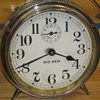Posted 15 years ago
 Chadakoin
Chadakoin
(73 items)
The sleek Streamline Moderne "Zephyr" electric cyclometer clock was made by the Pennwood Co. of Pittsburg, Penn., beginning around 1939 and continuing until the onset of World War II. Like the rest of Pennwood's wood cased clocks, its production was not resumed after the war.
Pennwood was perhaps the first company to market a 'digital' clock, beginning in the early 1930s (Warren Telechron filed for a cyclometer patent a month before Pennwood, Feb. 1933). Their movements were also used in GE, Lawson, and Seth Thomas clocks, among others.


























we have a pennwood digital clock, bakelite
it keeps excellent time
we are curious about its approx value?
Also is there anything we need to do regarding light oiling?
we recevied from a family whose father was a clock maker and they were about to toss it and we expressed interest based upon its design
pictures to follow
The value of Pennwood's bakelite clocks varies widely based on model/desirability and, of course, condition. Re oiling - generally, if it's functioning properly and not making a lot of noise, then don't. Particularly if you don't have some experience with these. If you do decide to oil, then use only light clock oil, preferably synthetic, with an applicator designed specifically for clocks ( pen-type applicators often on ebay for $1-2...). Use very sparingly - one tiny drop on pivot points only - is almost always enough.
Looking forward to your pictures!
Tom and Mary,
According to "20th Century Modern Clock Desk, Shelf and Decorative" by Mark V. Stien, Pennwood made three Zephy clocks two in bakelite brown and Ivory and one walnut cased. The brown clock is worth $75, the ivory $100, the walnut cased clock is worth $750. These prices relfect clocks in pristine condition with fine normal wear.
This is a lovely clock, in excellent condition. I just wanted to point out that the rolling wheel "cyclometer" mechanisms in Barr digital clocks are entirely different from those used in Pennwood/G.E./Lawson clocks. I've written a bit about this on my site, decopix.com.
Randy,
Right you are. Thanks, don't know how that bit of misinformation got left in there. The Pennwood mechanisms are crafted much better and are far more reliable than those used by Barr, in my experience. You've got an amazing site, I've spent hours and hours there...
Hi,
I just purchased the same model as the clock pictured above at an antique store in Portland, OR. It seems to be working and keeping time. It appears that it may have been refinished with some sort of clear coat but it shows the wear one would expect from a 1939 clock and I don't know the amount of sheen it had when new to compare. There is a 5" scratch across the back of the clock. Other than that it looks like it's in great shape. I was wondering if you had any idea (rough estimate) of its value?
Thanks!
Morgan
I love the warm colour and shape, very nice...:-)
I have one of the Walnut ones in not great condition. I think it could be great for parts or totally a restoration project. Anybody have a sense of a fair asking price?
I have one of the Walnut models that is in excellent condition every where except the output gear. I have owner the clock since 1939. Would like to find another one for parts. Email: jwagnon@gt.rr.com if you care to help or have one like it
JHWagnon, the movement from any Pennwood/Numechron/ Tymeter clock should work in your clock; the mounts, etc, remained essentially unchanged over time. What I've found, though, is that the earliest ones used a more compact motor and there may be a slight clearance issue with some of the later motors.